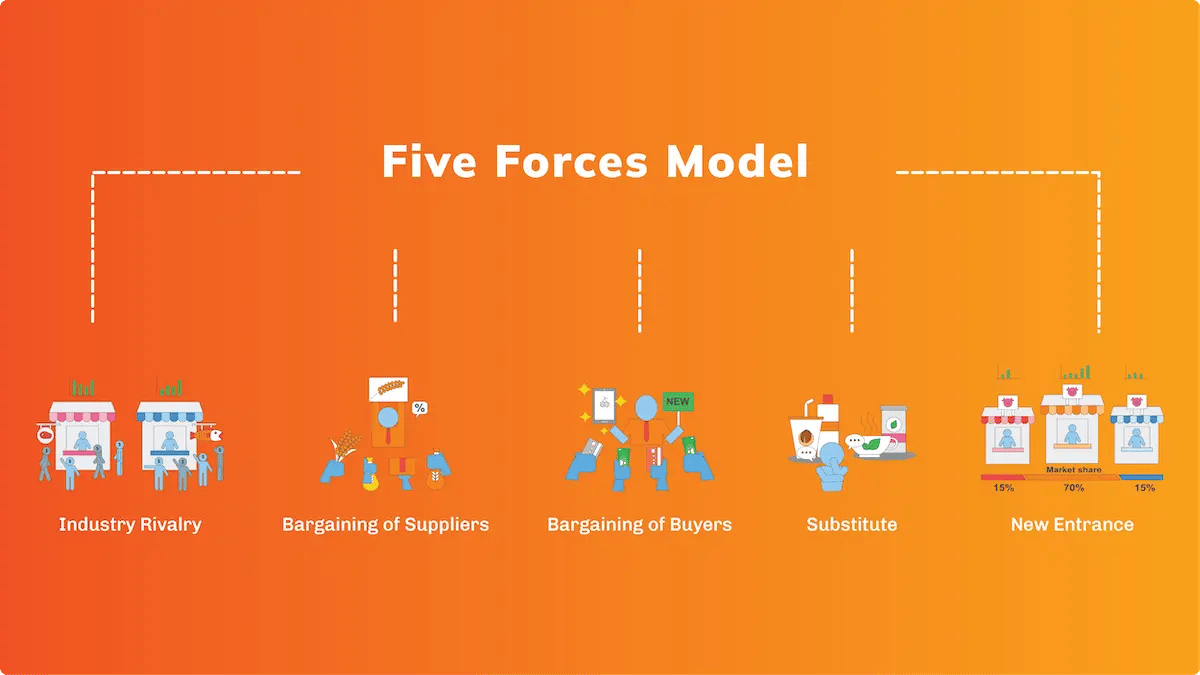Porter’s Five Forces Model: The Complete Explanation
When it comes to succeeding in any type of market, one of the most important things you can do is to research and understand the industry you are in. However, this is often easier said than done. This is where Porter’s Five Forces come in.
The Porter’s Five Forces model is a system designed to identify and analyze the different forces that shape an industry to identify its strengths and weaknesses. The most interesting thing about this model is that it was designed to work in virtually any industry and has continued to be a cornerstone when it comes to understanding different sectors of the economy.
Intrigued? We thought you might be. Take a further look at the Porter’s Five Forces Model to see for yourself how it works.
| Porter's Five Forces Model |
What is the Porter’s Five Forces Model?
The Porter’s Five Forces Model is a system designed to identify and analyze five competitive forces that make up every industry. The primary goal of this model is to help businesses determine an industry’s strengths and weaknesses. The system does this with an emphasis on five distinct forces:
- Competition in the industry
- Potential of new entrants into the industry
- Power of suppliers
- Power of customers
- The threat of substitute products
This system was named after Harvard Business School professor Michael E. Porter and it is often used today to help identify an industry’s structure to help determine the appropriate corporate strategies. This versatile system can be applied to virtually any industry as a way to determine the level of competition within the industry and enhance long-term profitability.
What Are The Five Forces?
Porter’s Five Forces were meticulously crafted to help create a holistic picture of an industry and of a certain corporation’s place in that industry. Let’s take a look at each of these forces in-depth.

Competition in the Industry
The first of the Porter Five Forces has to do with competition in the industry. Here, it is important to look at the number of competitors within a certain market and their ability to undercut a potential company in that industry.
The more competitors and the more products and services these competitors offer, the lesser the power of the company is. This is because both shoppers and suppliers will seek out a company’s competitors when they are looking for a better deal on something. This means companies may have to lower their prices to stay competitive.
On the other hand, when competition is low, a company has great power within the industry and the ability to charge higher prices because they have less competition. This can lead to more sales and higher profits.
Potential of New Entrants In The Industry
The second of Porter’s Five Forces has to do with the potential of competition. In this force, it is important to look at the probability that new companies will enter the market. This can also impact a company’s power within its industry and could weaken its position within its market.
How do you determine the potential for this to happen?
It all has to do with the barrier to entry. If it takes little time and money for a new company to enter the market, that is a weak barrier to entry and makes it more probable that the competition will grow.
On the other hand, if an industry has a strong barrier to entry, it means it is more difficult for new companies to break into the existing market. This is ideal for existing companies who want to be able to charge higher prices for their products and continue to dominate their markets.
Power of Suppliers
The next factor in Porter’s system has to do not with competition but with the power of suppliers. This simply means how easy it is for supplies to drive up the cost of certain things. Here’s how to determine the power of a supplier:
- The number of suppliers of key inputs or components of a good or service
- How unique those components are
- How much it costs a company to switch to another supplier
- How many suppliers there are in the industry (the fewer the number of suppliers—the more a company needs to depend on that supplier)
Ultimately, if the supplier has more power, can drive up the costs, and have all of the leverage when doing deals with companies in their industry. Conversely, when suppliers have little power or the market is saturated with these suppliers, companies can keep costs low and enjoy higher profits.
The Power of Customers
It isn’t just the company that holds all of the power, customers wield a great deal of power as well and they actually can drive prices lower if companies aren’t careful. The power of customers has to do with how many buyers or customers a company has and how significant each customer is.
Another factor to consider is how much money it would cost a brand to expand to a new target market of consumers or add new customers to their existing market.
When a brand has a smaller client base, it means that each customer has the power in their hands to want better deals and lower prices. On the other hand, a company that has many independent customers will have an easier time charging higher prices.
The Threat of Substitutes
The final component of the Five Forces is the threat of substitute goods or services. These are things that can ultimately replace a company’s products or services, posing a threat to that company’s power.
When a company offers goods or services that have no real potential substitute, they have plenty of power to increase its prices and it can help with business-to-business negotiations. However, when there is a threat of close substitutes, it can cause serious issues for a brand. Customers will have the option to completely forgo buying that product altogether and not only turn to another brand but to another product altogether—and this can seriously weaken a company’s power.
Conclusion
There is so much valuable information that can come from Porter’s Five Force System, including how you can apply this system to determining profits for your own business. Today, business managers and analysts still rely on this system.
Remember, there is a lot that goes into determining the potential profitability of a company and this system is sure to help companies figure out some of the most significant details involved.
 You've made it this far and you've learned so much. Congratulations!
You've made it this far and you've learned so much. Congratulations!
If you're looking to learn more about marketing or Ecommerce in general, feel free to reach out to us at: solutions@undigital.com
You May Also Like
These Related Stories

Understanding the Types of Personalization

The Marketing AIDA Model Explained


